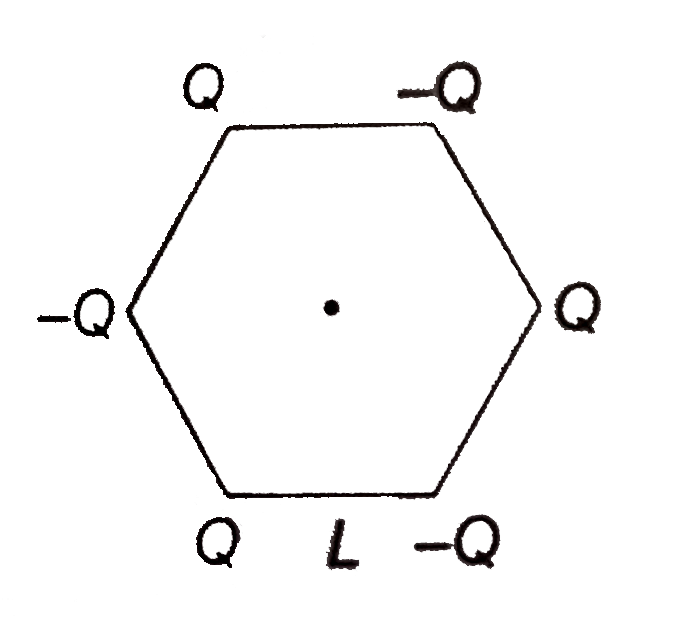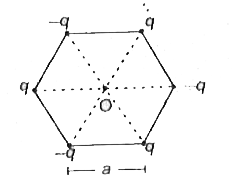The point charges are placed on the vertices of regular hexagon of side L as shown. Find the potential energy of the system of charges.

Number of pairs =6(6−1)2=15
(a) Six pairs (Q,−Q) at separation L.
(b) 
Six pairs (Q,Q:Q,Q:Q,Q,−Q,−Q,−Q,−Q,−Q,−Q) at separation √3L.
(c) 
Three pairs (Q,−Q) at separation 2L.
u=14π∈0[Q(−Q)L×6+Q.Q√3L×6+(Q)(−Q)2L×3]
=Q24π∈0L[−6+2√3−32]
Topper's Solved these Questions
Similar Questions
Knowledge Check
Six point charges are placed at the vertices of a regular hexagon of side a as shown. If E represents electric field and V represents electric potential at O then,
 AE = 0 but V ≠ 0BE ≠ 0 but V = 0CE = 0 and V = 0DE ≠ 0 and V ≠ 0
AE = 0 but V ≠ 0BE ≠ 0 but V = 0CE = 0 and V = 0DE ≠ 0 and V ≠ 0
What is potential energy for a system of charges?
View SolutionSix equal point charges q each are placed at six corners of a hexago of side a. Find out potential energy of charge system

View SolutionThree points charges are placed at the corners of an equilateral triangle of side L as shown in the figure:

View SolutionFour identical point charges q are placed at four corners of a square of side a. Find the potential energy of the charge system.
 .
.
View SolutionFive point charges, each +q are placed on five vertices of a regular hexagon of side' l '. Find the magnitude of the resultant force on a charge –q placed at the centre of the hexagon.
View SolutionFive point charges each of charges +q are placed of five vertices of a regular hexagon of side 'l'. Find the magnitude of the resultant force on a charge -q placed at the centre of the hexagon.
(##U_LIK_SP_PHY_XII_C01_E09_018_Q01.png" width="80%">
View SolutionFour point charges Q , q Q and q are placed at the corners of a square of side 'a' as shown in the Fig. Find the
potential energy of this system .
View Solution

